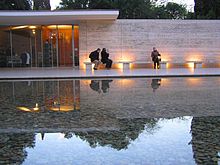
Architect Ludwig Mies van der Rohe adopted the motto "Less is more" to describe his aesthetic tactic of arranging the numerous necessary components of a building to create an impression of extreme simplicity, by enlisting every element and detail to serve multiple visual and functional purposes (such as designing a floor to also serve as the radiator, or a massive fireplace to also house the bathroom). Designer Buckminster Fuller adopted the engineer's goal of "Doing more with less", but his concerns were oriented towards technology and engineering rather than aesthetics. A similar sentiment was industrial designer Dieter Rams' motto, "Less but better" adapted from van der Rohe. The structure uses relatively simple elegant designs; ornamentations are quality rather than quantity[dubious – discuss]. The structure's beauty is also determined by playing with lighting, using the basic geometric shapes as outlines, using only a single shape or a small number of like shapes for components for design unity, using tasteful non-fussy bright color combinations, usually natural textures and colors, and clean and fine finishes. Using sometimes the beauty of natural patterns on stone cladding and real wood encapsulated within ordered simplified structures, and real metal producing a simplified but prestigious architecture and interior design. May use color brightness balance and contrast between surface colors to improve visual aesthetics. The structure would usually have industrial and space age style utilities (lamps, stoves, stairs, technology, etcetera), neat and straight components (like walls or stairs) that appear to be machined with machines, flat or nearly flat roofs, pleasing negative spaces, and large windows to let in lots of sunlight. This and science fiction may have contributed to the late twentieth century futuristic architecture design, and modern home decor. Modern minimalist home architecture with its unnecessary internal walls removed may have led to the popularity of the open plan kitchen and living room style.
Another modernmaster who exemplifies reductivist ideas is Luis Barragán. In minimalism, the architecturaldesigners pay special attention to the connection between perfect planes, elegant lighting, and careful consideration of the void spaces left by the removal of three-dimensional shapes from an architectural design. The more attractive looking minimalist home designs are not truly minimalist, because these use more expensive building materials and finishes, and are relatively larger.
Contemporary architects working in this tradition include John Pawson, Eduardo Souto de Moura, Álvaro Siza Vieira, Tadao Ando, Alberto Campo Baeza, Yoshio Taniguchi, Peter Zumthor, Hugh Newell Jacobsen, Vincent Van Duysen, Claudio Silvestrin, Michael Gabellini, andRichard Gluckman.[2]
The term minimalism is also used to describe a trend in design and architecture where in the subject is reduced to its necessary elements. Minimalist design has been highly influenced by Japanese traditional design and architecture. In addition, the work of De Stijl artists is a major source of reference for this kind of work. De Stijl expanded the ideas that could be expressed by using basic elements such as lines and planes organized in very particular manners.source










0 comments:
Speak up your mind
Tell us what you're thinking... !